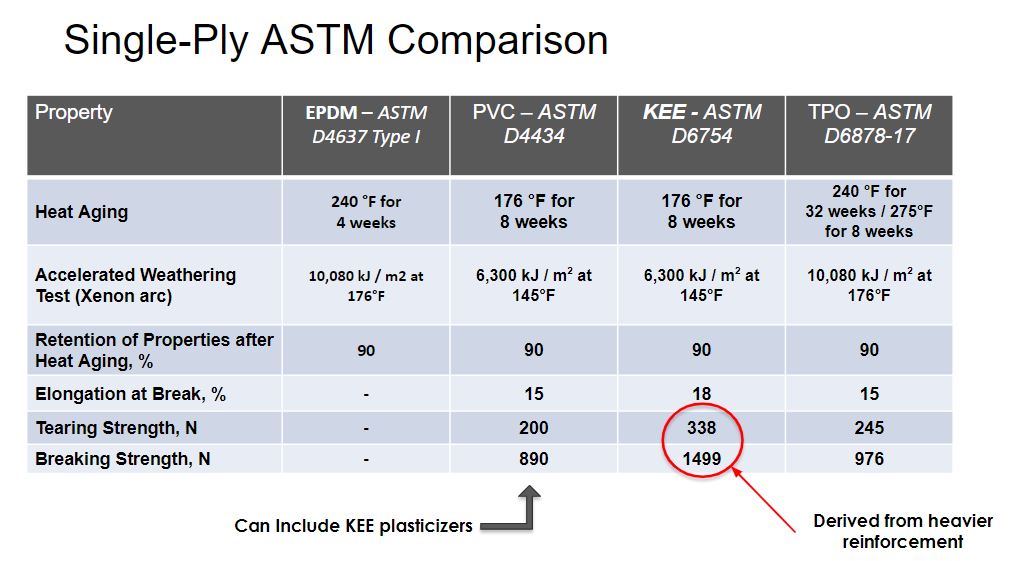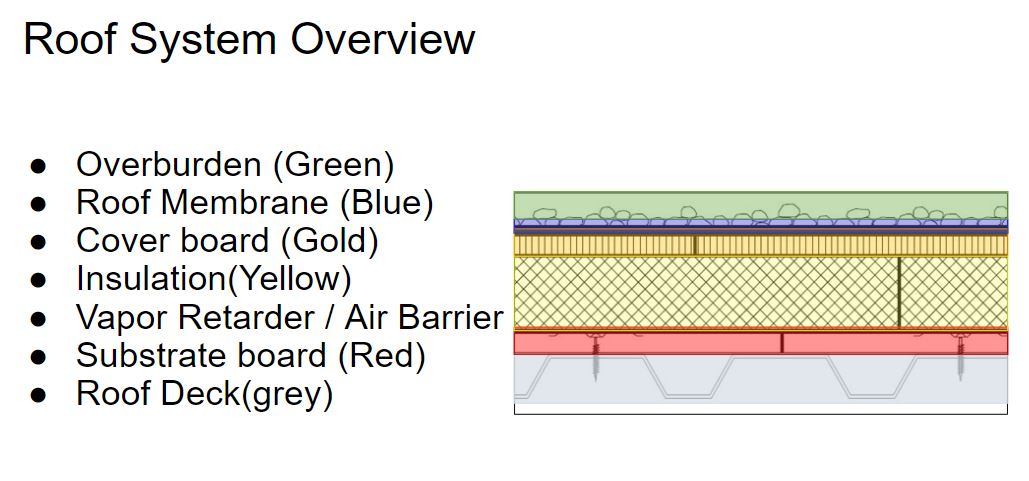Improving Energy Efficiency in Single-Ply Roofing
TPO (Thermoplastic Polyolefin)
TPO membranes were first introduced into the roofing market in the early 1980’s and were standardized with the creation of ASTM D6878 in 2003. Currently, TPO has greater than 50 percent of the low slope commercial roofing market share due to its lower material cost and speed of installation.
TPO membranes consist of three main components: a UV resistant cap, a core (reinforcement scrim), and a base. These three components are fused together during the manufacturing process. The cap and the core consist of similar components, but the cap contains UV and heat stabilizers, which provide long-term weathering resistance. TPO is inherently flexible without the use of plasticizers and dimensionally stable over time. Due to its chemical composition, TPO is naturally fungal resistant and has generally good resistance to chemicals. However, acids, greases, and oils should be avoided. Compatibility for any potential chemicals on the roof should always be confirmed.
TPO is manufactured in rolls that are shipped to the site and rolled onto the roof with no additional membrane layers required. After the membrane is rolled out onto the roof, the seams are heat welded together. When welded at the proper speed and temperature, the seam becomes monolithic with the rest of the roof membrane and is the strongest component of the roof. TPO membranes are typically white in color, but can be manufactured in a range of standard and custom colors, including various reflective colors other than just white. It is therefore highly popular for cool roofing applications.
TPO is typically manufactured in thicknesses of 45 mil, 60 mil, and 80 mils, with and without fleece backing, and they can be mechanically attached, adhered, ballasted, and induction welded. The wide range of thicknesses and installation methods make TPO a versatile choice for a wide range of applications.
Performance highlights:
- Strong, heat-welded seams.
- Inherently flexible, contains no plasticizers.
- Will not gray over time and has no fungal growth in warm climates.
PVC (Polyvinyl Chloride)
PVC roofing was created in Switzerland and Germany in the 1960’s and was subsequently introduced to the US in the 1970’s. This single-ply membrane is flexible which allows for easier detailing. PVC also offers increased chemical resistance compared to EPDM and TPO. PVC has a steady market share due to its increased resistance to oil, grease, and chemicals.
PVC is a thermoplastic like TPO and the seams are heat welded together. The seam becomes a monolithic component roof and is the strongest component of the roof. PVC membranes are typically white in color, but can be manufactured in a range of standard and custom colors, including various reflective membranes other than just white. PVC is typically manufactured in thicknesses of 50 mil, 60 mil, and 80 mil, with and without fleece backing, and it can be mechanically attached, adhered, ballasted, and induction welded.
Standard PVC membranes consist of a liquid plasticizer that enables the PVC polymer to become flexible. Over time, the liquid plasticizer can leach out of the membrane and cause the membrane to become more rigid again, which in extreme cases can lead to cracking under stress or movement. While this was a concern with early PVC membranes, in current formulations this is less of a concern unless it is put in contact with asphaltic products which cause the plasticizers to leach out at a faster rate. As with any roofing membrane, compatibility for any potential chemicals on the roof should always be confirmed. Over time algae and mildew may grow on the membrane surface largely due to the migration of the liquid plasticizers, this growth can negatively impact reflectivity.
Performance Highlights:
- Excellent resistance to oil and grease.
- Very flexible during installation, good for detailing.
- Reflective colors available.
PVC KEE is a variation of a PVC membrane that includes a solid plasticizer known as KEE (Ketone Ethylene Ester). This solid plasticizer does not leach from the membrane and provides enhanced weatherability as a result. PVC KEE also has best in class resistance to chemicals including jet fuel, oils, and greases, and is ideal for restaurant or airport roofing applications.
Performance Highlights:
- Better long-term weathering.
- Best in class resistance to oil and grease.
- Remains flexible over lifecycle.
Material Comparison
ASTM standards have been developed to provide the minimum quality standards for manufacturers to follow. Viewing them side by side can offer a useful comparison when deciding between single-ply roofing membrane material types for a given project. The table below highlights some of the differences in performance characteristics and accelerated weathering requirements for the different single-ply membranes.

Selecting Your Supporting Cast: Roof Attachments and the Role in Roof Durability
While the single-ply membrane may take the starring role, a roofing "system" is composed of multiple components that must work together to provide the best overall protection.
The basic roof components for a low-slope commercial roof may include:
- Roof deck
- Substrate board/roof board & vapor retarder/air barrier
- Insulation–2 layers minimum
- Cover board
- Roof membrane
- Overburden (elements like vegetation, ballast, or solar installations)

Basic roof components of a low-slope roof.









